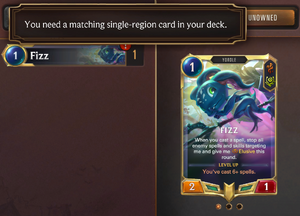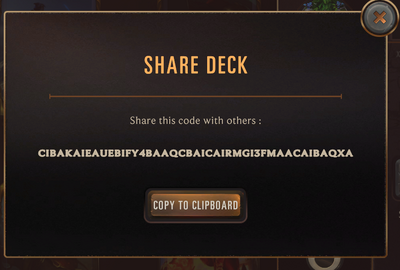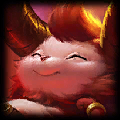This article or section may require clean-up to meet League of Legends Wiki's quality standards. Reason given:
|
A deck is a collection of cards assembled before a match, as well as where players ![]() draw cards from (and sometimes add cards to) during gameplay.
draw cards from (and sometimes add cards to) during gameplay.
Decks for use in Constructed modes can be created in the ![]() Collection tab and modified either there or in the
Collection tab and modified either there or in the ![]() Play tab when selecting a deck. A player can have a maximum of 30 decks stored in their collection at once.
Play tab when selecting a deck. A player can have a maximum of 30 decks stored in their collection at once.
Players start with starter decks, but can customize or replace these. Deck sharing is a feature that allows players to easily import and export each other's decks using deck codes.
The in-game appearance of a deck (and the cards in it) can be customized with Card Backs.
Construction[]
- This section is about creating decks for the Constructed format. For the deck building process in Expeditions, see Expeditions (Legends of Runeterra).
Decks are added to the Collection via the Deck Builder or by importing decks. They can then be changed in the deck builder. Only collectible cards from the player's collection ("owned cards") can be added. Decks with unowned cards can be gained through importing. It is however not possible to include non-collectible cards, which are only generated by other, collectible cards. Moreover, only collectible cards are encoded in the deck code.
There are restrictions on the cards that can be added to a deck that depend on the ruleset chosen for that specific deck. Decks typically need to contain 40 cards and at most 6 champions, in addition to special region and duplicate constraints depending on the ruleset. Decks that do not satisfy the rules or contain unowned cards can still be created, saved, exported, and imported, but can not be chosen for games.
Constructed decks are used in versus AI, casual play, ranked, friendly matches, gauntlets, and certain labs.
Starter Decks[]
- Main article: Starter Deck (Legends of Runeterra)
To aid new players, some basic cards and decks are added to the player's collection during the tutorial road. These are pre-built decks, but can be treated as any other deck, i.e. they can be edited or deleted.
Deck Builder[]
The player can choose to create a new deck or edit an existing one in the Collection tab in the decks section. The deck builder will open and allow them to add or remove cards from their collection.
The player can select which constructed format they'd like the deck to use in the deck builder as well as the cover art using the button at the top left corner. Once the player has cards from the maximum number of regions allowed, cards from all other regions will be grayed out and can't be added to the deck. The numbers at the bottom left display how many champions and total cards, respectively, the deck has in respect to the maximum allowed. Adding more or fewer than 40 cards, or more than 6 champions, to the deck will cause the number to be highlighted red, and the deck will be listed as invalid and unplayable once saved until the numbers have been corrected. This can also happen should the player have more than 1 copy of a card in singleton format, or the deck list has cards the player doesn't own in their collection.
The player can give the deck a name on the top left and add HTML codes to format it.[1] Decks not named will simply be given the name "New Deck" when saved. To the right of the name text field is a button to see the number of ![]() champions,
champions, ![]() spells,
spells, ![]() units, and
units, and ![]() landmarks currently in the deck, as well as bar graph displaying the total number of cards for each mana value. This allows the player to quickly analyze the deck's consistency of different card types and tempo.
landmarks currently in the deck, as well as bar graph displaying the total number of cards for each mana value. This allows the player to quickly analyze the deck's consistency of different card types and tempo.
At the top, there is button to open a filter for card types, rarity, ![]() mana cost, set, or any other special categories. Next to it is a button toggle showing cards the player owns 0 copies of, a
mana cost, set, or any other special categories. Next to it is a button toggle showing cards the player owns 0 copies of, a ![]() region filter, and a search bar which will filter cards by name, keywords, groups (such as Elnuk or Elite), or other card text. The search will also filter by cards associated with a card (such as
region filter, and a search bar which will filter cards by name, keywords, groups (such as Elnuk or Elite), or other card text. The search will also filter by cards associated with a card (such as ![]() 5Heimerdinger's turrets).
5Heimerdinger's turrets).
Multi-region[]

Warning displayed when adding a multi-region card.
When adding a multi-region card to a deck, the player must also include at least one mono-region card from one of that card's regions or the deck will be considered invalid. After doing so, the multi-region card is treated as being of that region exclusively. For example, adding ![]() 1Fizz and then
1Fizz and then ![]() Bilgewater cards will make the deck a mono-Bilgewater deck. The player can then add
Bilgewater cards will make the deck a mono-Bilgewater deck. The player can then add ![]() 3Lulu and
3Lulu and ![]() Ionian cards to make a Bilgewater/Ionia deck. This is only for the purposes of the deck and the cards themselves will still retain the properties of their excluded region. However, cards effects that specify "from your regions" will only use the regions of the deck itself even if multi-region cards have other included regions.
Ionian cards to make a Bilgewater/Ionia deck. This is only for the purposes of the deck and the cards themselves will still retain the properties of their excluded region. However, cards effects that specify "from your regions" will only use the regions of the deck itself even if multi-region cards have other included regions.
Exporting and Importing[]
In order to share information across players, the game provides standardized ways to refer to cards and decks: Card Codes and Deck Codes encode the necessary information to identify each.
From the Deck Collection tab, players can choose to import decks by copying the deck code and clicking the Import Deck button at the top. They can also export their own decks by selecting them and clicking share, which gives them a deck code they can share with others. A player can import a deck even if they don't have all the cards included in it in their collection, though it will be considered invalid and the deck can't be used until they own the cards.
Card Codes[]
Every card has a corresponding card code, all of which are listed here. The codes for collectible cards are seven-character strings with the first two denoting the set, the second two denoting the region, and the last three being a number corresponding to that card. For example, ![]() 5Lux's card code is 01DE042: 01 for
5Lux's card code is 01DE042: 01 for ![]() Set 1, DE for
Set 1, DE for ![]() Demacia, and 042 is Lux's card number. Most non-collectible cards will instead have a "T" followed by a number, following the first collectible card they're associated with as their card code (
Demacia, and 042 is Lux's card number. Most non-collectible cards will instead have a "T" followed by a number, following the first collectible card they're associated with as their card code (![]() 3 Lux's Prismatic Barrier card code is 01DE042T1).
3 Lux's Prismatic Barrier card code is 01DE042T1).
Deck Codes[]
Deck codes are created using card codes through the following process:[2]
- All encodings begin with 4 bits for format and 4 bits for version.
- Cards are grouped together based on how many copies of the card are in the deck (e.g., cards with three copies are grouped together, cards with two copies are grouped together, and cards with a single copy are grouped together).
- Within those groups, lists of cards are created which share the same set and region.
- The set/region lists are ordered ascending by increasing length. The contents of the set/region lists are ordered by card number.
- Variable length integer (varint) bytes for each ordered group of cards are written into the byte array according to the following convention:

The popup when sharing a deck. The code is the one shown when incorrectly importing a deck.
- How many lists of set/region combination have three copies of a card
- How many cards within this set/region combination follow
- Set
- Region
- Card number
- Card number
- ...
- How many cards within the next set/region combination follow
- Set
- Region
- Card number
- Card number
- ...
- Repeat for the groups of two copies of a card
- Repeat for the groups of a single copy of a card
The regions are mapped to numbers as followed: ![]() Demacia (DE)=0,
Demacia (DE)=0, ![]() Freljord (FR)=1,
Freljord (FR)=1, ![]() Ionia (IO)=2,
Ionia (IO)=2, ![]() Noxus (NX)=3,
Noxus (NX)=3, ![]() Piltover & Zaun (PZ)=4,
Piltover & Zaun (PZ)=4, ![]() Shadow Isles (SI)=5,
Shadow Isles (SI)=5, ![]() Bilgewater (BW)=6,
Bilgewater (BW)=6, ![]() Shurima (SH)=7,
Shurima (SH)=7, ![]() Targon (MT)=9.
Targon (MT)=9.
The resulting byte array is then base32 encoded into a string.
During a match[]
While in a match, the deck serves as a primary source to ![]() draw cards from, and displays useful information about the current state of the deck to both players. The deck of remaining undrawn cards is displayed on the bottom left for the player, and the top right for their opponent.
draw cards from, and displays useful information about the current state of the deck to both players. The deck of remaining undrawn cards is displayed on the bottom left for the player, and the top right for their opponent.
Visible Information[]
The following can be seen when clicking on a deck:
- Deck name: Only if it's the player's own, constructed deck.
- Region icons: The card region(s) that the deck consists of.
 Champions: Champion cards and respective
Champions: Champion cards and respective  level up progress, if it can progress in the deck. Clicking on a champion brings the player to the card view of the champion card.
level up progress, if it can progress in the deck. Clicking on a champion brings the player to the card view of the champion card.- Cards and
Traps left: The number of cards that can be drawn, as well as the number of
 Poison Puffcaps inside the deck (if any). It displays the total number only and does not track unique cards or how many traps are on each individual card.
Poison Puffcaps inside the deck (if any). It displays the total number only and does not track unique cards or how many traps are on each individual card.
The Deck enters a special animation when going ![]() deep (and there are cards in the deck that utilize the Deep keyword). Furthermore, there are other animations playing on or with the deck, such as
deep (and there are cards in the deck that utilize the Deep keyword). Furthermore, there are other animations playing on or with the deck, such as ![]() 4Maokai's Level Up.
4Maokai's Level Up.
Decking Out[]
When there are no cards left in the deck, it will disappear. This indicates the player will lose the game the next time they try to draw a card, unless they can add more cards to the deck.
Manipulating the deck[]
During the game, the player's (and the opponent's) deck can be interacted with in the following ways:
 Drawing: Drawing cards from the player's deck or the opponent's deck (e.g.
Drawing: Drawing cards from the player's deck or the opponent's deck (e.g.  Nab), or drawing cards with certain requirements (e.g.
Nab), or drawing cards with certain requirements (e.g.  4 "a unit with X power",
4 "a unit with X power",  4 "a spell with X costs",
4 "a spell with X costs",  3 "a landmark").
3 "a landmark").- Generating: Creates cards and shuffles them into a deck. If no other information is present, it targets the player's deck, but it is possible to generate cards in the opponent's deck as well (e.g.
 0 Pesky Specter). Can include non-collectible cards or other cards that were not part of the original deck. Changes to a deck in-game don't affect the actual contents of the deck outside of it.
0 Pesky Specter). Can include non-collectible cards or other cards that were not part of the original deck. Changes to a deck in-game don't affect the actual contents of the deck outside of it. - Shuffling: Shuffles (or "places") a card from the hand or the board (or even the deck) into the deck. (e.g.
 3 Stalking Shadows or
3 Stalking Shadows or  2 Pick a Card).
2 Pick a Card).
Deck-Targeted effects[]
Some effects target or refer to cards in the deck, including the following:
- Buffing some or all of the
 units or cards in the deck (e.g.
units or cards in the deck (e.g.  1 Omen Hawk,
1 Omen Hawk,  2 Shared Spoils or
2 Shared Spoils or  7 Smooth Soloist)
7 Smooth Soloist) - Everywhere effects
Allegiance effects




